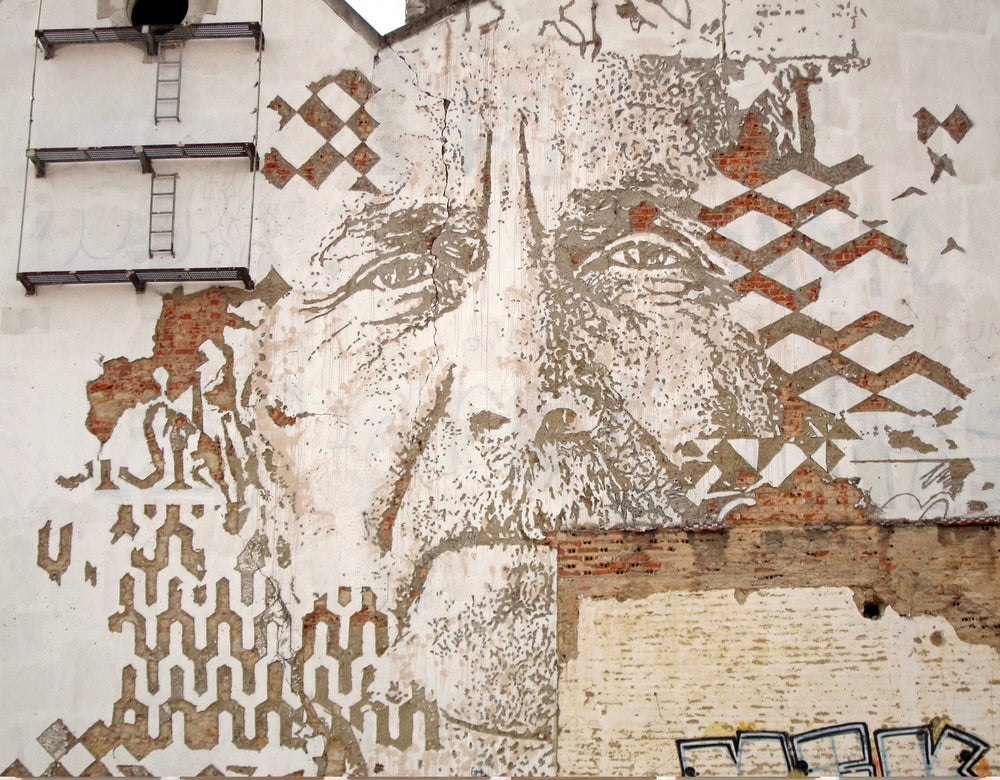
Who is it Vhils?
Graffiti art was not always a recognized or mainstream cultural expression, at least until the arrival of the 21st century. His story is as fascinating as that of Portuguese graffiti artist Alexandre Farto, better known as Vhils. The work of Vhils It is part of the so-called Street Art or urban art, whose popularity exploded precisely thanks to graffiti in the 1970s in New York. Like all art, graffiti is a personal and subjective expression that can take the form of rubric, political-social protest or seek a purely aesthetic purpose. In case of Vhils there is a bit of everything, so we will start by talking about its beginnings, which emerged in the industrial district of Seixal, in Portugal.
Origin of Vhils
Every self-respecting artist has a more or less identifiable origin, and with Vhils It could not be otherwise. As he himself says, Vhils He made his first graffiti at the age of 12 on the surface of several trains in his city, with the sole intention of painting his tag there. Although uncommissioned street art runs the risk of being sanctioned and becoming an act of vandalism, the reality is that Vhils it was unknowingly part of the history of what Americans call tagging or pseudonymous signatures. Without tagging you cannot understand the history of graffiti, nor the history of graffiti itself. Vhils, since this action gave rise to the proliferation of very diverse artistic sources on the canvas of the urban scene and made Vhils the great contemporary artist he is today.
We imagine his first adventures, spay in hand, through Portugal where he was born in 1987. Seven years earlier, Street Art was already beginning to gain critical recognition but Vhils I didn't know yet if this criticism would welcome him with open arms in the near future. The first years of the new millennium aroused in the Portuguese the need to continue expressing themselves, and around 2004, they began working with techniques such as stenciling and etching, joining a great driver in their artistic life, the gallerist Vera Cortés, who supported and promoted him in several exhibitions. With the same creative impulse, Vhils He ventured abroad to study at the Byam Shaw School of Art in London. There, in Anglo-Saxon territory, he developed what has now become an innovative technique of international reference for graffiti art, the technique of “excavating” urban walls.
Vhils sets a precedent
While the abandoned areas of the South Bronx continued to witness intense graffiti activity, the city walls of Lisbon were filled with bas-relief sculptures of Vhils during the first years of the millennium. And they left nothing to be desired in the work of their North American colleagues and counterparts at the Fashion Moda gallery, opened in the 1980s in the Bronx.
With some remnants of artistic interventionism, characterized by the modification of objects, environments and spaces, Vhils he revealed his now famous scratched images in Scratching the Surface and at the London Cans Festival 2008. And then, certainly, Vhils he revolutionized the traditional approach to this classic technique with his work on the surface of buildings, an act that was profoundly influenced by the transformations that Portuguese urban growth experienced during the 80s and 90s. Vhils, aware of the reorganization of the city's spaces and the fragility of some facades, covers not only their most “superficial” side, but also their structural aspects. That's why he likes to modify and “destroy” the environment, so that viewers become more aware that the immobility of buildings and the safety of the environment are just a pipe dream.
A committed and human artist
Vhils he states that “being an artist was never among his plans, it was never an ambition” and that he learned what “discipline” is at the street graffiti school. The transformative art of Vhils, added to this type of particular statements, not only made him stand out as an avant-garde reference, but also as someone committed and human, very human.
This is demonstrated in his speeches around the world, where in addition to making us reflect on the transitory, he takes us to an immediate and, unfortunately, harsh reality. Vhils he knows that his art can be an instrument of protest and a double-edged sword: on the one hand, the portrait of ordinary people converted into icons of the citizen space; on the other, the use of risky techniques such as explosions and 3D modeling, which integrate its philosophy of destruction with new technologies.
Notable works by Vhils
Although Vhils Although he is known mainly for his mural works, the truth is that urban portraits are only part of his artistic catalogue. Making a review of the most striking and remarkable works of Vhils in recent times, we find some pieces such as the Flicker Series from 2016, in video installation format with remnants of Pop Art and Asian culture; the Highlight series from the same year in which Vhils creates 3D portraits with assembled foam and wire; the Gleam Series made of neon lights, which once again transport us to those Japanese and American night streets that taste like Blade Runner and retro-futurism; or the Diminish Series and the Palimpsest, from 2018 and 2019 respectively, which function as advertising posters collected directly from the street.
Of the latest installations, Overexposure #01 from 2019 stands out, which, without losing the humanistic intentionality of the usual portraits Vhils, continues to invest in the use of innovative materials such as motion sensors, microcontrollers and tubular lamps, or the Gamut 2020 Series, which create the most spectacular video installations for the eyes and senses.






